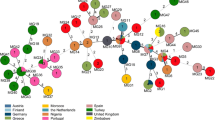Abstract
We investigated six microsatellite markers to type 85 unrelated and 118 related isolates of Candida glabrata from 36 patients. Three new markers were selected from the complete sequence of CBS138 and three previously described markers, RPM2, MTI and ERG3 were used. We found a genetic diversity of 0.949 by combining four of them. By applying the new microsatellite markers GLM4, GLM5 and GLM6 we were able to discriminate 29 isolates, originally identified by the more established markers, RPM2, MTI and ERG3. When epidemiologically closely related isolates from 36 patients were typed, 25 patients (72%) exhibited identical or highly related multilocus genotypes. We noted a microvariation in 4 of the patients. This minor change of one locus could be explained by a single step mutation. Since one of these patients had not received antifungal treatment; thus, the relationship between genome variation and antifungal therapy remains controversial. We can conclude from our analysis of these new microsatellite markers that they are highly selective and therefore should be considered as a useful typing system for differentiating related and unrelated isolates of C. glabrata, as well as being able to detect microvariation.


Similar content being viewed by others
References
Trick WE, Fridkin SK, Edwards JR, Hajjeh RA, Gaynes RP, National Nosocomial Infections Surveillance System Hospitals (2002) Secular trend of hospital-acquired Candidemia among intensive care unit patients in the United States during 1989–1999. Clin Infect Dis 35:622–630
Wilson AG, Pharm D, Scott Micek T, Pharm DZ, Ritchie DJ, Pharm DA (2005) Retrospective evaluation of fluconazole for the treatment of Candida glabrata fungemia. Clin Ther 27:1228–1237
Lockhart SR, Joly S, Pujol C, Sobel JD, Pfaller MA, Soll DR (1997) Development and verification of fingerprinting probes for Candida glabrata. Microbiology 143:3733–3746
Redding SW, Kirkpatrick WR, Saville S, Coco BJ, White W, Fothergill A (2003) Multiple patterns of resistance to fluconazole in Candida glabrata isolates from a patient with oropharyngeal candidiasis receiving head and neck radiation. J Clin Microbiol 41:619–622
Fan SR, Bai FY, Liao QP, Liu ZH, Li J, Liu XP (2008) Genotype distribution of Candida albicans strains associated with different conditions of vulvovaginal candidiasis, as revealed by microsatellite typing. Sex Transm Infect 84:103–106
Hanafy A, Kaocharoen S, Jover-Botella A, Katsu M, Iida S, Kogure T, Gonoi T, Mikami Y, Meyer W (2008) Multilocus microsatellite typing for Cryptococcus neoformans var. grubii. Med Mycol 46:685–696
Vanhee LM, Symoens F, Nelis HJ, Coenye T (2008) Microsatellite typing of Aspergillus fumigatus isolates recovered from deep organ samples of patients with invasive aspergillosis. Diagn Microbiol Infect Dis 62:96–98
Bottrel F, Desterke C, Costa C, Bretagne S (2001) Analysis of microsatellite markers of Candida albicans used for rapid typing. J Clin Microbiol 39:4076–4081
Sampaio P, Gusmavo L, Correia A, Alves C, Rodrigues AG, Pina-Vaz C, Amorim A, Pais C (2005) New microsatellite multiplex PCR for Candida albicans strain typing reveals microevolutionary changes. J Clin Microbiol 43:3869–3876
Sampaio P, Gusmavo L, Alves C, Pina-Vaz C, Amorim A, Pais C (2003) Highly polymorphic microsatellite for identification of Candida albicans strains. J Clin Microbiol 41:552–557
Brisse S, Pannier C, Angoulvant A, de Meeus T, Diancourt L, Faure O, Muller H, Peman J, Viviani MA, Grillot R, Dujon B, Fairhead C, Hennequin C (2009) Uneven distribution of mating types among genotypes of Candida glabrata isolates from clinical samples. Eukaryot Cell 8:287–295
Foulet F, Nicolas N, Eloy O, Botterel F, Gantier J-C, Costa J-M, Bretagne S (2005) Microsatellite marker analysis as a typing system for Candida glabrata. J Clin Microbiol 43:4574–4579
Grenouillet F, Millon L, Bart JM, Roussel S, Biot II, Didier E (2007) Multiple-locus variable-number tandem-repeat analysis for rapid typing of Candida glabrata. J Clin Microbiol 45:3781–3784
Al-Aidan AW, Goessens W, Toom NL, Al-Ahdal M, Belkum A (2007) Microevolution in genomic short sequence repeats of Candida albicans in non-neutropenic patients. Yeast 24:155–160
Odds FC, Davidson AD, Jacobsen MD, Tavanti A, Whyte JA, Kibbler CC, Ellis DH, Maiden MCJ, Shaw DJ, Gow NAR (2006) Candida albicans strain maintenance, replacement, and microvariation demonstrated by multilocus sequence typing. J Clin Microbiol 44:3647–3658
Fugita S, Hashmito T (2000) DNA fingerprinting patterns of Candida species using Hinf1 endonuclease. Intern J Syst Evol Microbiol 50:1381–1389
Rozen S, Skaletsky H (2000) Primer3 on the WWW for general users and for biologist programmers. Methods Mol Biol 132:365–386
Nei M (1987) Molecular evolutionary genetics. Columbia University Press, New York
Michalakis Y, Excoffier L (1996) A generic estimation of population subdivision using distances between alleles with special reference to microsatellite loci. Genetics 142:1061–1064
Dodgson AR, Pujol C, Pfaller MA, Denning DW, Soll DR (2005) Evidence for recombination in Candida glabrata. Fungal Genet Biol 42:233–243
Dodgson AR, Pujol C, Denning DW, Soll DR, Fox AJ (2003) Multilocus sequence typing of Candida glabrata reveals geographically enriched clades. J Clin Microbiol 41:5709–5717
Lin CY, Chen YC, Lo HJ, Chen KW, Li SY (2007) Assessment of Candida glabrata strain relatedness by pulsed field gel electrophoresis and multilocus sequence typing. J Clin Microbiol 45:2452–2459
Boldo XM, Villa-Tanaca L, Zuniga G, Hernandez-Rodriguez C (2003) Genetic diversity among clinical isolates of Candida glabrata analysed by randomly amplified polymorphic DNA and multilocus enzyme electrophoresis analyses. J Clin Microbiol 41:4799–4804
Klempp-Selb B, Rimek D, Kappe R (2000) Karyotyping of C.albicans and C. glabrata from patients with Candida sepsis. Mycoses 43:159–163
Shin JH, Chae MJ, Song JW, Jung SI, Cho D, Kee SJ, Kim SH, Shin MG, Suh SP, Ryang DW (2007) Changes in karyotype and azole susceptibility of sequential bloodstream isolates from patients with Candida glabrata candidemia. J Clin Microbiol 45:2385–2391
Acknowledgement
This study was financially supported by the Minister of High Education and Scientific Research.
Author information
Authors and Affiliations
Corresponding author
Rights and permissions
About this article
Cite this article
Abbes, S., Sellami, H., Sellami, A. et al. Candida glabrata strain relatedness by new microsatellite markers. Eur J Clin Microbiol Infect Dis 31, 83–91 (2012). https://doi.org/10.1007/s10096-011-1280-4
Received:
Accepted:
Published:
Issue Date:
DOI: https://doi.org/10.1007/s10096-011-1280-4




